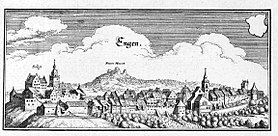Capuchin monastery Engen
| Capuchin monastery Engen | ||
|---|---|---|
| medal | Capuchin | |
| founding year | 1618 | |
| Cancellation / year | 1820 | |
| Start-up | new order | |
| Patronage | Mary the Angel | |
| location | ||
| country | Germany | |
| region | Baden-Württemberg | |
| place | Narrow | |
| Geographical location | 47 ° 51 ' N , 8 ° 46' E | |
|
|
||
| Situation in Germany | ||
The Capuchin monastery in Engen is an abandoned monastery of the Capuchin order in the city of Engen . The foundation stone was laid in 1618. The monastery was closed in 1820 and converted into a hospital by 1825 , which burned down in 1883. The lay church was rebuilt in the foundation walls as a hospital church in 1887. The underground Capuchin crypt next to it has been preserved.
history
founding
The provincial chapter of the Swiss Capuchin Province in Lucerne from September 16 to 21, 1616 received a letter from Bishop Jakob Fugger of Constance , who conveyed the wish of Mayor Christophor Vogler and the Deanery Engen to found a monastery in the city. The Lutheran sovereign Maximilian von Pappenheim had previously given his approval. Only after the city insisted on the provincial chapter in Lucerne from September 14 to 20, 1618 in Lucerne, the monastery project was tackled.
The monastery
In October 1618 the foundation stone was laid by the abbot of the Rheinau monastery Eberhard III. von Bernhausen-Kempten (1613–1642) placed on rocky terrain below the Ballenberg. Vogler and the citizens donated the necessary funds for the construction. The construction was directed by the Fabriciarius of the order Adrian Mailin von Stockach. On August 20, 1620, the lay church was consecrated by the Constance suffragan bishop Johann Anton Tritt von Wilderen in honor of Mary of the Angels. During the plague epidemic of 1635, the Capuchins were involved in nursing, whereby two priests died from the plague. During the siege and capture of Engen in 1640, Johann Ludwig von Erlach took his quarters in the monastery and bombarded the city from the monastery garden. On April 16, 1668, the new Upper Austrian Capuchin Province split off from the Swiss Capuchin Province. It was believed that the Swiss had always been averse to the Austrians. In 1725, by order of the provincial chapter, a chapel was added to the lay church in honor of the religious saint Felix of Cantalice with an underground crypt. When a typhus epidemic lasted for over half a year in autumn 1771, the Capuchins again took care of the sick, with several priests themselves falling victim to the disease. After a decree of the Viennese government of April 4, 1781, the Engener Capuchin Monastery was incorporated into the newly founded Swabian Capuchin Province. During the coalition wars, the monastery was used and plundered by both parties in 1796, 1799 and 1800.
secularization
On December 28, 1802, the Fürstenberg government put the monastery on the extinction budget. In January 1810, eight fathers and two lay brothers lived in the monastery, four of whom died by 1814. In 1820 the monastery was abolished. After the desecration of the monastery church by the parish priest Josef Anton Schlosser, the movable inventory was auctioned on October 28, 1820. Most of the furnishings in the lay church remained on site.
Furnishing
Parts of the church furnishings, such as the tabernacle of the Fidelis altar, the cross particles and paraments, passed into the possession of the city pastor in 1820. The furnishings of the lay church that remained on site were almost completely destroyed by the fire of 1883. The altarpiece of the Capuchin Church, painted in 1729 by Josef Ignatius Wegscheider and depicting the martyrdom of Saint Fidelis von Sigmaringen after Sebastiano Conca , has been in the possession of the town of Engen . It was saved from the fire in the Capuchin Church in 1883.
Dissolution of the library
Two volumes from the monastery library marked Loci capuc. Engae were given to the Rheinau monastery in 1769 and are now owned by the Zurich Central Library . Five missals and five books of requiem were transferred to the court chapel in Donaueschingen in 1820 . A volume from the Engen monastery library is listed in the incunable catalog of the Germanic National Museum in Nuremberg under the number 817.
literature
- Romualdus Stockacensis: Monasterium Engensis . In: Historia provinciae anterioris Austriae fratrum minorum capucinorum . Andreas Stadler, Kempten 1747, pp. 101-104; Text archive - Internet Archive
- Beda Mayer OFMCap .: Capuchin monastery Engen. In: The Capuchin Monasteries of Front Austria (Helvetia Franciscana, Volume 12, 7th issue). St. Fidelis-Buchdruckerei, Lucerne 1977, pp. 188–197.
- Alois Baader: The Engener Capuchin Monastery . In: Herbert Berner (Ed.): Engen im Hegau. Center and official city of the Hewen rule . Volume 2. Thorbecke, Sigmaringen 1990, 337-366.
Web links
- Capuchin monastery Engen in the database of monasteries in Baden-Württemberg of the Baden-Württemberg State Archives
Individual evidence
- ^ Beda Mayer OFMCap .: Capuchin monastery Engen. In: The Capuchin Monasteries of Front Austria (Helvetia Franciscana, Volume 12, 7th issue). St. Fidelis-Buchdruckerei, Lucerne 1977, pp. 188–197.
- ^ The district of Konstanz: official district description, Thorbecke, 1968, p. 486.
- ^ Richard Schell: Fidelis of Sigmaringen . Thorbecke, Sigmaringen, 1977, illustration p. 61.
- ↑ Zurich Central Library, Valentin Koerner Verlag, 2008, p. 185 and p. 197.
- ^ Barbara Hellwig, Walter Matthey: Incunable catalog of the Germanisches Nationalmuseum Nürnberg . Otto Harrassowitz Verlag, 1970, p. 251.

